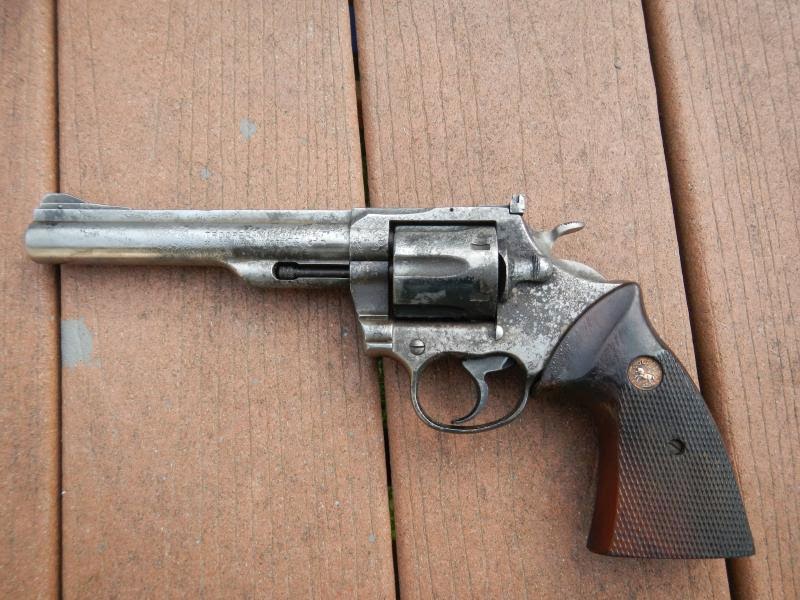I decided to call this the Phoenix Project because
this gun, a Colt Trooper MkIII, was found in the ashes of a house fire
and the owner would like me to "bring it back to life".
The guns surface was pitted heavily and looked horrible....I'll let the pictures speak for themselves:
Some of you might view this gun and think that the heat may have damaged the steel. Not to worry, the heat was not that great.
From my research:
Medium to high carbon steels are heated above 2000 degrees when forged.
The steel is then draw tempered between 400 & 700 degrees.
Before
the Hot Salts bluing method was invented, guns used to be "cooked" in
hot charcoal to blue the steel, this would impart a surface heat
treatment. The metal being charcoal blued is exposed to temperatures
nearing 1000 degrees. Also the color case hardening process (which
imparts a thin hardening of the surface layer) is done at +/- 1400
degrees.
Wood generally will
ignite at temperatures between 250 and 400 degrees. The wood grips on
this gun had some blistering of the varnish, but were otherwise intact.
In addition the blistering was only on the flange area at the front/top
of the grips.
The internal parts
and springs also showed no signs of damage. My guess is that this was
hidden somewhere in the house, it was insulated from the intense heat,
perhaps limiting its exposure to 200 or maybe 300 degrees.
The
item(s) that insulated the gun were soaked with water when the fire was
put out and it was this moisture, held against the surface for a time,
was what caused the corrosion.
A little history on the Colt Trooper:
The
Colt Trooper MK III was introduced in 1969, as a new design with a
transfer bar style safety. The Troopers were built on the J frame (not
to be confused with the S&W J frame). The Colt J Frame is a medium
sized frame, comparable in size the the Ruger GP100 or S&W L frame.
The
internal parts were designed without soft "wear points" like the
Pythons and earlier Colt guns (which were hand fitted for a perfectly
smooth trigger pull). Instead these parts were precision machined and
then they performed surface heat treating that left the bearing surfaces
very wear resistant.
In the opinion of many, this is the strongest, best designed medium framed revolver ever made.
The only weakness is the firing pin. On some of the guns the firing pins were a bit too brittle and can break when dry fired.
The
Mk III Trooper came in three barrel lengths: 4", 6" & 8" and three
finishes: Bright Blue, Bright Nickel Plating and a Satin Electroless
Nickel Plating called "ColtGuard".
This
particular gun dates to 1978. It came factory equipped with the "target
package" including target sights, oversize target grips, wide spur
target hammer and smooth target trigger with the Bright Blue finish.
Just for reference, this what the gun looked like when it was new:
A Colt ad from 1979
The owner started the process of removing the pits,
then gave up and re-blued it using a cold bluing solution. I then
offered him to see what I could do, as a learning project.
Here is what it looked like when he brought it to me:
The bore doesn't look much better than the outside, but I can still see the grooves, so maybe there is hope?
I
plan on removing all the pits, trying to maintain the rounded and sharp
edges. I will not concern myself with the roll marks, they are a lost
cause.
I am looking into having an engraver remark the barrel and frame.
Stay tuned, this will be a long journey I think.....
If you need to find the build date of your Colt, you might be able to find it here: http://www.proofhouse.com/colt/index.html



















No comments:
Post a Comment